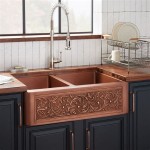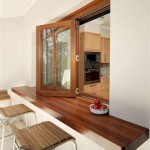What Is The Normal Height Of A Kitchen Table?
Determining the normal height of a kitchen table is crucial for ensuring comfortable and functional dining experiences. The height influences posture, ease of eating, and compatibility with chairs and benches. Standardization in kitchen table heights allows for interchangeability of seating options and facilitates a cohesive aesthetic within the dining area.
While variations exist to cater to specific needs and design preferences, a general consensus governs the commonly accepted height range. Understanding this standard, along with the factors that might necessitate deviations from it, is essential for individuals designing or furnishing a kitchen or dining space.
Deviation from the standard height can lead to discomfort, strain, and an awkward dining experience. Selecting the appropriate height, therefore, requires careful consideration of several parameters, including the height of the individuals who will be using the table and the intended purpose of the table itself.
The Standard Kitchen Table Height
The standard height for a kitchen table is typically between 28 and 30 inches (71 to 76 centimeters). This measurement is taken from the floor to the top surface of the table. While the range allows for some flexibility, most mass-produced and custom-built kitchen tables fall within this parameter.
This standard height is predicated on the average height of adults and designed to accommodate a comfortable seating position for most individuals. The standard height allows for adequate legroom and enables users to easily reach their plates and utensils without straining. The 28-30 inch range also aligns well with the standard height of dining chairs, ensuring a consistent and ergonomic dining experience.
The consistency in standard height facilitates the mixed-and-matching of different table and chair styles. Individuals can purchase tables and chairs separately, confident that the heights will be compatible. This modularity contributes to ease of furnishing a home and simplifies the replacement of individual items.
While the standard height serves as a useful guideline, it is not an absolute rule. Various factors can influence the ideal height of a kitchen table in specific circumstances. These factors include the type of seating used, the intended purpose of the table, and the physical characteristics of the individuals who will be using it. Understanding these influencing factors is key to making informed decisions about table height.
Factors Influencing Kitchen Table Height
Several factors can influence the selection of an appropriate kitchen table height, influencing deviations from the established 28-30 inch standard. These factors can include seating styles, intended table usage, and the physical characteristics of the users.
Seating Style: The type of seating used with the kitchen table significantly impacts the ideal table height. Standard dining chairs typically have a seat height of 17-19 inches. This seat height provides adequate legroom and allows for a comfortable reach to the tabletop when paired with a standard 28-30 inch table. However, if bar stools or counter-height chairs are intended for use with the kitchen table, then a higher table, often referred to as a counter-height table, is required. Counter-height tables typically measure between 34 and 36 inches high. Similarly, if lower seating options, such as floor cushions or benches, are preferred, a lower table height may be more appropriate.
Intended Table Usage: The intended use of the kitchen table also plays a critical role in determining the appropriate height. A table primarily used for dining benefits from adhering to the standard height to maintain comfortable dining posture. However, if the table is intended for other purposes, such as food preparation, standing work, or crafting, a higher table height might be preferable. Taller tables can reduce strain on the back and neck when performing tasks that require extended periods of standing or working in a bent-over position. Conversely, if the table serves as a children's play area, a lower height might be more appropriate to ensure ease of access for younger users.
User Physical Characteristics: The physical characteristics of the individuals who will be using the table also influence the ideal table height. Taller individuals may find that a standard-height table feels too low, causing them to stoop or slouch while eating. In such cases, a slightly taller table, closer to the 30-inch end of the standard range, or even a custom-built higher table, may be more comfortable. Conversely, shorter individuals may find a standard-height table too high, causing them to strain their shoulders or have difficulty reaching their plates. In these cases, a table closer to the 28-inch end of the standard range, or even a custom-built lower table, may be more appropriate. Individuals with mobility issues or those who use wheelchairs may also require adjustments to table height to ensure accessibility and comfort. An adjustable-height table can be particularly useful in households with diverse needs.
Measuring for the Ideal Kitchen Table Height
Determining the ideal kitchen table height for a specific situation involves careful measurement and consideration of the factors described above. The goal is to choose a height that promotes comfort, good posture, and ease of use for all individuals who will be using the table.
Seat Height Measurement: The first step is to measure the seat height of the chairs or benches that will be used with the table. Seat height is measured from the floor to the top of the seat. The ideal distance between the seat and the tabletop is typically between 10 and 12 inches. This spacing allows for adequate legroom and enables users to comfortably reach their plates and utensils. To determine the ideal table height, add 10-12 inches to the seat height measurement. For example, if the chairs have a seat height of 18 inches, the ideal table height would be between 28 and 30 inches.
User Height Considerations: Next, consider the height of the individuals who will be using the table. If there is a significant difference in height among users, it may be necessary to compromise on the table height to accommodate everyone. A table height that is comfortable for the tallest user may be too high for the shortest user, and vice versa. In such cases, adjustable seating options, such as chairs with adjustable height settings, can be beneficial. Alternatively, consider purchasing a table with adjustable legs or adding table leg extenders to customize the height accurately.
Simulating the Dining Experience: Before making a final decision, it can be helpful to simulate the dining experience with the chosen chairs and a makeshift table of the proposed height. Place the chairs around the makeshift table and sit at it to evaluate comfort and ergonomics. Pay attention to posture, legroom, and reach. If the makeshift table feels too high or too low, adjust the height and repeat the simulation until the ideal height is determined. This hands-on approach can help to avoid costly mistakes and ensure that the kitchen table is comfortable and functional for all users.
Considering Table Thickness: When calculating the final table height, remember to factor in the thickness of the tabletop itself. The measured height should be from the floor to the top surface of the table. If the tabletop is particularly thick, it will reduce the available legroom and may necessitate a slightly higher table height. Conversely, if the tabletop is thin, it may be possible to use a slightly lower table height without compromising legroom.
Customization Options: If standard table heights do not meet the specific needs of the household, consider exploring customization options. Many furniture makers offer custom-built tables that can be tailored to the exact desired height. Customization allows for complete control over the dimensions of the table, ensuring a perfect fit for the space and the users. Alternatively, consider purchasing adjustable height table legs, which allow for easy adjustment of the table height as needed. These legs are particularly useful in households with diverse needs or where the table is used for multiple purposes.
By carefully considering these factors and taking accurate measurements, individuals can select a kitchen table height that promotes comfort, functionality, and a pleasurable dining experience.

What Is The Ideal Dining Table And Chair Height

What Is The Ideal Dining Table And Chair Height

What Is The Ideal Dining Table And Chair Height

Sauder Boone Mountain Sindoori Mango Engineered Wood Counter Height Dining Table 427126 The Home Depot

Optimum Size Of Kitchen Furniture With Respect To Human Dimensions

Everything You Need To Know About Dining Kitchen Table Heights

Average Dining Table Height Inches Forum Iktva Sa

A Guide To Choosing The Ideal Dining Table Width

Multifunctional Normal Standard Height Apartment Size Stainless Steel Kitchen Dining Table China Waterproof Small Space Made In Com

Dining Table Size Guide Picking The Right Dimensions
Related Posts








